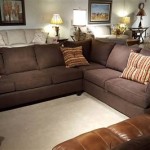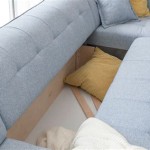Average Size Sofa Dimensions: A Comprehensive Guide
The sofa serves as a central piece of furniture in many living spaces, providing seating, comfort, and contributing significantly to the overall aesthetic of a room. Determining the appropriate sofa size is a critical step in interior design, influencing both the functionality and the visual balance of the area. Selecting a sofa that is either too large or too small can disrupt the harmony of a room, making it appear cramped or sparsely furnished.
This article provides a comprehensive guide to understanding the typical dimensions of average-sized sofas, exploring the various factors that influence sofa sizing, and offering practical advice on selecting the right sofa dimensions for a specific room. The information presented aims to empower individuals to make informed decisions when purchasing a sofa, ensuring that it aligns with their spatial needs, lifestyle requirements, and aesthetic preferences.
Understanding Standard Sofa Dimensions
While the term "average size sofa" suggests a definitive set of measurements, the reality is that sofa dimensions can vary significantly depending on the style, design, and manufacturer. However, certain ranges are commonly associated with what is considered an average or standard-sized sofa. These measurements generally account for sofas that comfortably seat three people.
The key dimensions to consider when examining sofa size are length (or width), depth, and height. Each of these dimensions plays a crucial role in determining the overall footprint of the sofa and its suitability for a particular space.
Length (Width): The length of a sofa is typically measured horizontally from one armrest to the other. An average-sized sofa will typically range in length from 78 inches (approximately 6.5 feet) to 96 inches (approximately 8 feet). Sofas at the shorter end of this range are often referred to as apartment-sized sofas, while those at the longer end offer more seating space. The length of the sofa heavily influences how much space it occupies along a wall and the number of people who can comfortably sit on it.
Depth: The depth of a sofa is measured from the front edge of the seat cushion to the back of the sofa frame. The standard depth for an average-sized sofa typically falls between 32 inches and 40 inches. Deeper sofas generally offer a more relaxed and lounge-like seating experience, while shallower sofas may be more suitable for formal living rooms or spaces where maximizing walking space is a priority. The depth also influences the seat height, which can affect how easily individuals can get in and out of the sofa.
Height: The height of a sofa is measured from the floor to the highest point of the backrest. Average sofa heights typically range from 30 inches to 36 inches. The height of the backrest contributes to the overall visual impact of the sofa and can influence the perceived spaciousness of the room. Lower backrests tend to create a more open and airy feel, while higher backrests can provide more back support and create a more formal appearance.
It is important to note that these measurements represent general guidelines and can vary depending on the specific sofa design. Factors such as the style of the armrests, the backrest design, and the presence of features like cushions or pillows can all affect the overall dimensions of the sofa.
Factors Influencing Sofa Size Selection
Choosing the right sofa size requires careful consideration of several factors beyond the standard dimensions. These factors include the size and layout of the room, the intended use of the sofa, and the overall design aesthetic of the space.
Room Size and Layout: The most critical factor in determining the appropriate sofa size is the size and layout of the room in which it will be placed. A large sofa in a small room can overwhelm the space, making it feel cramped and uncomfortable. Conversely, a small sofa in a large room can look insignificant and fail to provide adequate seating. Accurately measuring the room dimensions, including the length, width, and height, is essential before selecting a sofa. Consider the placement of other furniture, such as coffee tables, side tables, and entertainment centers, to ensure that the sofa fits comfortably within the existing layout.
The layout of the room also plays a crucial role. Consider the traffic flow and pathways through the space. Ensure that there is sufficient space to move around the sofa without obstruction. Leave adequate space between the sofa and other furniture pieces to create a sense of openness and avoid a cluttered appearance. Using painter's tape to mark out the dimensions of the potential sofa on the floor can be a helpful visual aid in determining its suitability for the space.
Intended Use: The intended use of the sofa should also be considered when determining the appropriate size. A sofa that will primarily be used for lounging and relaxation may benefit from a deeper seat and a more generous length. In contrast, a sofa that will be used for formal entertaining may be better suited to a more upright design with a shallower seat. Consider the number of people who will typically be using the sofa at the same time. If the sofa will frequently be used by multiple people, opting for a longer sofa that can comfortably accommodate everyone is advisable. If the sofa will primarily be used by one or two people, a smaller sofa may be sufficient.
Design Aesthetic: The overall design aesthetic of the room should also influence the sofa size selection. A modern, minimalist room may benefit from a sleek, low-profile sofa with clean lines. A traditional room may be better suited to a more classic sofa with a taller backrest and more ornate details. The sofa should complement the existing furniture and décor in the room, creating a cohesive and harmonious look. Consider the color, fabric, and style of the sofa in relation to the overall design scheme. A sofa that is too visually dominant can disrupt the balance of the room, while a sofa that is too understated may fail to make a significant impact.
Practical Tips for Selecting the Right Sofa Dimensions
Selecting the right sofa dimensions involves a combination of careful measurement, thoughtful consideration of the room's characteristics, and an understanding of personal preferences. The following practical tips can assist in the selection process:
Measure Accurately: Before browsing sofas, accurately measure the room dimensions using a measuring tape. Record the length, width, and height of the space, as well as the dimensions of any existing furniture that will be placed near the sofa. Consider the placement of windows, doors, and other architectural features that may affect the placement of the sofa.
Create a Floor Plan: Create a floor plan, either on paper or using an online design tool, to visualize the placement of the sofa in the room. Mark out the dimensions of the potential sofa on the floor plan and experiment with different arrangements to determine the optimal layout. Consider the traffic flow and the placement of other furniture to ensure that the sofa fits comfortably within the space.
Consider Doorways and Hallways: Before purchasing a sofa, ensure that it can be transported through doorways, hallways, and stairwells without difficulty. Measure the width and height of these access points to ensure that the sofa will fit through them. If the sofa is particularly large or bulky, consider whether it can be disassembled for easier transport.
Test the Comfort: Whenever possible, test the comfort of the sofa before purchasing it. Sit on the sofa in the store or showroom to assess the seat depth, back support, and overall comfort. Pay attention to the height of the seat and the angle of the backrest to ensure that it is comfortable for your body type. If purchasing online, read reviews and check the sofa's specifications carefully to ensure that it meets your comfort requirements.
Consider Scaled-Down Options: If space is limited, consider scaled-down versions of average-sized sofas, such as loveseats or apartment-sized sofas. These smaller sofas offer similar comfort and style while taking up less space. Alternatively, consider modular sofas, which can be configured to fit the specific dimensions of the room. Modular sofas also offer the flexibility to rearrange the seating arrangement as needed.
Don't Overlook Armrest Style: The armrest style significantly impacts the overall width and appearance of the sofa. Rolled arms, for instance, tend to occupy more space than track arms. Consider the armrest style in relation to the available space and the desired aesthetic.
By carefully considering these factors and following these practical tips, individuals can select a sofa with dimensions that are ideally suited to their needs and preferences, creating a comfortable and stylish living space.

Sofa Dimensions 101 Measuring For Your Perfect

Standard Sofa Dimensions For 2 3 4 And 5 Person Charts Diagrams Styling

Sofa Size Calculator

Sofa Dimensions For 2 3 4 And 5 Person Couches Charts Diagrams Formal Living Room Designs Design

Sofa Dimensions A Ultimate Guide With Drawings Homenish Layout Furniture Standard
Your Guide To Measuring For Sofa

Verona Sofa Birch Beige Urban Ladder
A Guide To Sofa Dimensions Sizes Seatup Llc

Standard Sofa Dimensions For 2 3 4 And 5 Person Charts Diagrams Engineering Discoveries

Six Common Mistakes When A Sofa And Ways To Avoid Them








